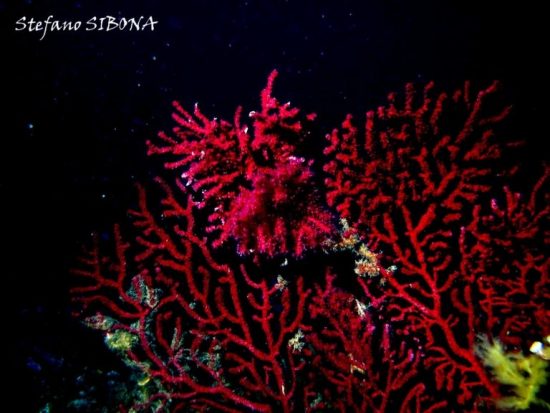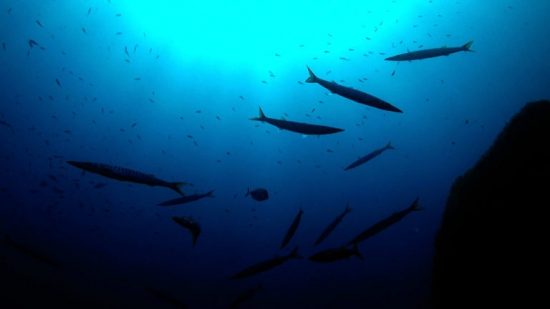






Secca Carega is the second shoal found in the Protected Marine Area of Portofino and still represents one of the best dive sites in the Mediterranean that should not be missing from any diver’s logbook.
Compared to the most famous shoal, Isuela, finding it is decidedly less difficult as it is located a few meters from the coast, in the proximity of the homonymous Punta Carega, between the point itself and a plaque at the water’s edge remembering the Genoese pioneer Dario Gonzatti. Gonzatti died in these waters in 1947 whilst testing one of the first ARO self-contained oxygen breathing equipment prototypes. The sea of Portofino was once the setting for many a rudimental equipment test dive by the precursors of modern scuba diving, including Ludovico Mares, founder of Mares.
The rock is found at 3m deep, and on nice days, with clear water, it is visible from the surface. I usually go around the shoal in an anti-clockwise direction, starting from the side facing the open water, towards the south. Here the wall descends vertically to 25 meters, forming a slight step that is lightly sloped and covered in Posidonia oceanica to then head back down, on the silt, to a bathymetry of 45 meters. It is a stretch that is rich in animal species and provides many points of observation and study for people like me who are passionate about marine biology.
After 30m I enter the realm of violescent sea-whip (Paramuricea clavata) which appears in numerous coloured colonies. On the sea bed, near a stretch in which the rock forms a clear corner, I stop to admire and photograph a fantastic fan of two-tone gorgonia (Paramuricea camaleons), whose intense yellow creates a wonderful contrast with the environment which is made dark by the depth.
I abandon the shoal for a minute, moving towards the open sea, looking for a pair of interesting masses that rise from the sand. They are covered in gorgonia and the nooks are inhabited by threatening moray eels.
I move back towards the shoal, and whilst I start to return to less challenging depths, my eyes get lost in the numerous cracks in the rock where red coral (Corallium rubrum) is overflowing.
The eastern side is completely covered in yellow gorgonia (Eunicella cavolinii) and is the place in which, with a now precise regularity, you can meet the famous “barracuda of the Carega”.
Once the area of yellow barracuda was limited to north Atlantic regions, between Capo Verde, the Canary Islands and the Azores. In the last 20 years, due to the global warming of the seas, this fish has slowly colonised the whole of the Mediterranean Sea, so much so that today it has been re-baptised the “barracuda of the Mediterranean”. It mostly lives in the open sea, swimming in large schools, at a depth of between 50 meters and the surface. It’s not rare to see it by the coast, near to the promontories and shoals, and it’s easy to see it at many dive sites in the Mediterranean. It is characterised by a long body, with a bluish/grey/silver colouring and classic black vertical lines on the spine. Its mouth is menacing, large and half-open, giving you a glimpse of its robust, intimidating teeth.
Today, here at Carega, there really are a lot of them! Swimming in midwater, back and forth, carried by the current in one direction and swimming against it in the other. I pass in-between them, choosing a few lucky specimen to observe even closer. I move away but feel the call of adrenalin once again. I return to the school, in amongst them, following the flow. Now I’m part of them and move around with the barracuda. I’m in trim, with my twin tanks on my back, with only the sound of my bubbles. I’m immersed in the blue, amongst the blue, together with the barracuda!
I continue my circumnavigation of Secca Carega and move towards the side facing the coast. Here the seabed rises, I’m at a maximum depth of 20 meters and cross an area rich of masses and large rock formations. Large groupers live here, with wonderful groups of corvina that dance to the rhythm of the current.
The time to resurface has arrived. The top of the shoal is ideal for my long decompression, but it’s not time wasted. Around me, large snappers pass quickly, searching for their prey.
Here, as with all dives in the Protected Marine Area of Portofino, I understand how important protecting the sea is. The result of twenty years of protection is before my eyes, or rather before my mask.
Sea fans are impressive, red corals grow day after day in a place that is finally adapted to their needs, colonies of hard corals cover the rock face and I swim happily among the fish who are not scared of noisy humans with their bulky equipment.
Taken from the original article, published in Italian here.
 Underwater Tales by Stefano Sibona
Underwater Tales by Stefano Sibona 16th August 2019
16th August 2019 Area Marina Protetta di Portofino, Camogli, Portofino, Santa Margherita Ligure, Metropolitan City of Genoa, Italy
Area Marina Protetta di Portofino, Camogli, Portofino, Santa Margherita Ligure, Metropolitan City of Genoa, Italy